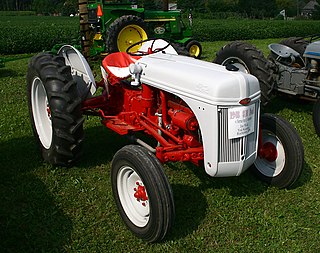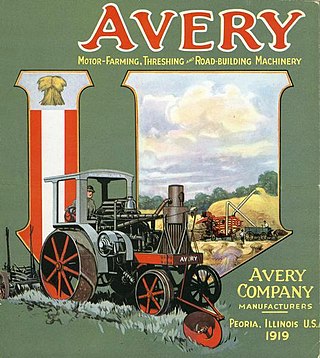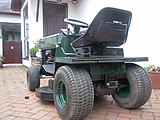
A tractor is an engineering vehicle specifically designed to deliver a high tractive effort at slow speeds, for the purposes of hauling a trailer or machinery such as that used in agriculture, mining or construction. Most commonly, the term is used to describe a farm vehicle that provides the power and traction to mechanize agricultural tasks, especially tillage, and now many more. Agricultural implements may be towed behind or mounted on the tractor, and the tractor may also provide a source of power if the implement is mechanised.

A lawn mower is a device utilizing one or more revolving blades to cut a grass surface to an even height. The height of the cut grass may be fixed by the design of the mower but generally is adjustable by the operator, typically by a single master lever or by a mechanism on each of the machine's wheels. The blades may be powered by manual force, with wheels mechanically connected to the cutting blades so that the blades spin when the mower is pushed forward, or the machine may have a battery-powered or plug-in electric motor. The most common self-contained power source for lawn mowers is a small internal combustion engine. Smaller mowers often lack any form of self-propulsion, requiring human power to move over a surface; "walk-behind" mowers are self-propelled, requiring a human only to walk behind and guide them. Larger lawn mowers are usually either self-propelled "walk-behind" types or, more often, are "ride-on" mowers that the operator can sit on and control. A robotic lawn mower is designed to operate either entirely on its own or less commonly by an operator on a remote control.

A mower is a person or machine that cuts (mows) grass or other plants that grow on the ground. Usually mowing is distinguished from reaping, which uses similar implements, but is the traditional term for harvesting grain crops, e.g. with reapers and combines.

Briggs & Stratton Corporation is an American manufacturer of gasoline engines with headquarters in Wauwatosa, Wisconsin.
Eshelman was a marque of small American automobiles (1953–1961) and other vehicles and implements including motor scooters, garden tractors, pleasure boats, aircraft, golf carts, snowplows, trailers, mail-delivery vehicles and more. The Cheston L. Eshelman Company was incorporated on January 19, 1942, and was based on the sixth floor of an industrial building at 109 Light Street in Baltimore, Maryland, with aircraft production facilities located in Dundalk, Maryland. The company president was Cheston Lee Eshelman, the first vice-president was Sidney S. Zell, and the first treasurer was Frank K. Kris.
Gravely, of Brillion, Wisconsin, is a manufacturer of powered lawn and garden implements which it describes as "walk-behind, zero turn and outfront mowers". It started as a manufacturer of "walk-behind" or two-wheel tractors.

The Avery Company, founded by Robert Hanneman Avery, was an American farm tractor manufacturer famed for its undermounted engine which resembled a railroad engine more than a conventional farm steam engine. Avery founded the farm implement business after the Civil War. His company built a large line of products, including steam engines, beginning in 1891. The company started with a return flue design and later adapted the undermount style, including a bulldog design on the smokebox door. Their design was well received by farmers in central Illinois. They expanded their market nationwide and overseas until the 1920s, when they failed to innovate and the company faltered. They manufactured trucks for a period of time, and then automobiles. until they finally succumbed to an agricultural crisis and the Depression.

The Holden Commodore (VY) is a full-size car that was produced by Holden from 2002 to 2004. It was the third iteration of the third generation of the Commodore. Its range included the luxury variants, Holden Berlina (VY) and Holden Calais (VY); commercial versions were called the Holden One Tonner (VY), Holden Ute (VY), and Holden Crewman (VY). In 2003, the range also saw the introduction of the first Commodore-based all-wheel drive variants, including the Holden Adventra (VY) wagon.

Thomas Green & Son, Ltd. were engineers who manufactured a wide range of products at the Smithfield Foundry, Leeds, United Kingdom

Two-wheel tractor or walking tractor are generic terms understood in the US and in parts of Europe to represent a single-axle tractor, which is a tractor with one axle, self-powered and self-propelled, which can pull and power various farm implements such as a trailer, cultivator or harrow, a plough, or various seeders and harvesters. The operator usually walks behind it or rides the implement being towed. Similar terms are mistakenly applied to the household rotary tiller or power tiller; although these may be wheeled and/or self-propelled, they are not tailored for towing implements. A two-wheeled tractor specializes in pulling any of numerous types of implements, whereas rotary tillers specialize in soil tillage with their dedicated digging tools. This article concerns two-wheeled tractors as distinguished from such tillers.

Wheel Horse was a manufacturer of outdoor and garden power equipment, including lawn and garden tractors. The company's headquarters were in South Bend, Indiana, USA.
Roths Industries, Inc. (1945–1960) was a manufacturer of small garden tractors and other agricultural equipment founded by Herbert C. Roths in Alma, Michigan. The company manufactured Garden King Walking Tractors, BesRo Riding Tractors, and Till Ro Stalk Cutters.

The Allis-Chalmers D series is a line of tractors made by the Allis-Chalmers Manufacturing Company from 1957 to 1969.

A zero-turn riding lawn mower is a standard riding lawn mower with a turning radius that is effectively zero when the two drive wheels rotate in opposite direction, like a tank turning in place.
Ingersoll Power Equipment is a garden and compact tractor manufacturer located in Portland, Maine. As of 2005, it is under the ownership of Eastman Industries.
The GE Elec-Trak was the first commercially produced all-electric garden tractor, made mostly between 1969 and 1975 at GE's Outdoor Power Equipment Operation under Bruce R. Laumeister. The previous work of Laumeister at GE on the experimental Delta electric car that debuted in 1968 helped pave the way for the production of the Elec-Trak. Despite the limited production and availability of the electric tractors, many Elec-Traks are still in use today and have a cult following among tractor and electric vehicle enthusiasts. They are an archetypal or seminal design that has influenced all later electric tractors.
Jacobsen Manufacturing has produced lawn mowers and light-duty tractors in the United States from the early 1920s until around 2020. They were located in Racine, Wisconsin from 1921 to 2001, when they moved to Charlotte, North Carolina. In 2017, Jacobsen moved from Charlotte to Augusta, Georgia. In 2020, it was announced they would relocate from Augusta, Georgia to their sister factory of Ransomes-Jacobsen in Ipswich, England, UK. They are currently owned by Textron since acquisition in 1975.

A riding mower, also known as a ride-on mower, tractor mower or lawn tractor, is a type of lawn mower on which the operator is seated, unlike mowers which are pushed or towed.

Hayter is a British high-end manufacturer and distributor of garden machinery, specialising in industrial and domestic lawn mowers. The company's headquarters are located in Spellbrook, Hertfordshire, where it was founded in 1946 by Douglas Hayter, a pioneer of the rotary mower. The company was awarded a Royal Warrant in 1960.




















